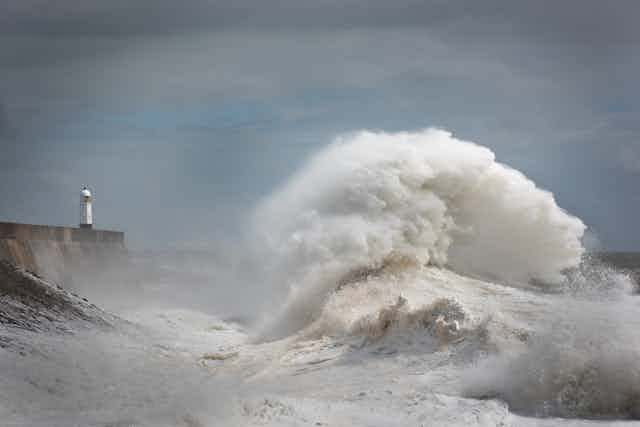Since 2015, the UK’s Met Office has used forenames to label storms, as a strategy for improving people’s awareness of severe weather warnings. The list of names for the 2023 storm season was compiled in conjunction with the Irish forecaster Met Éireann and KNMI, the Dutch national weather forecasting service.
The list includes forenames suggested by the British public – Daisy, Glen, Khalid, Owain – as well as the winner of a public vote on Twitter, Betty. KNMI has honoured famous Dutch scientists with its selections: Antoni, Hendrika, Johanna, Loes, Tobias and Wouter. And Met Éireann has plumped for Cillian, Fleur, Íde, Ruadhán and Nelly.

Getting the public involved in naming storms injects an element of fun into the otherwise serious business of heightening awareness of perilous weather. When we use people’s names for non-human things, we anthropomorphise (or humanise) them, and so they gain more of our interest and attention. But naming storms also has its pitfalls.
How storm names reflect cultural tendencies
With the exception of Cillian, which was the ninth most popular given to baby boys in Ireland in 2021, the 2022-23 storm names tend not to mirror today’s popular baby names. In terms of popularity, Wouter and Hendrika are the next most highly ranked baby names on the list (being respectively, the 37th most popular name given to baby boys and the 42nd for baby girls in the Netherlands).
In other words, compared to Noah, Ella or Emma, they’re not overly trendy.
They do however reflect the cultures, religions, ethnicities and linguistic diversity of the countries involved. Íde is an old Irish saint’s name, Owain is Welsh, Khalid is Arabic, Priya is Sanskrit and Loes is the Dutch form of Louise.
Also, the storm names replicate the cultural tendency in Europe and elsewhere for forenames to be gendered. Most of the names on the list are what naming specialists identify as typically female or typically male forenames. The list alternates on this basis.
Almost all of the typically female names in the list end in a (phonetic) vowel (Hendrika, Ide, Johanna, Priya) or they are a pet form (Betty, Daisy, Nelly). These elements are considered to be linguistic femininity markers, that is, linguistic features that occur predominantly in female names and only rarely in male names.
Likewise, most of the male names in the list show the typical linguistic masculinity markers found within many Germanic languages, including in English and Dutch. All apart from Antoni end in a consonant.
Masculine names can hold greater prestige and there is debate about whether storms with feminine names are taken less seriously. Given this, the inclusion in this year’s list of three gender-neutral names (Glen, Sam and Val) is to be welcomed.

Naming things can adversely impact eponymous people
Using people’s forenames to identify things such as storms, that are not people, can also have unintended consequences. In 2015, Isis was removed from the UN’s storm name list and people with the name Isis have faced stigma, because it is now associated with a terrorist group. Similary, the devasting hurricane Katrina of 2005 led to this forename dropping down the rankings of popular baby names in the US, from position 281 to 942 in 2012.
Naming problems have been a constant thread throughout the pandemic too. Mere geographical names for new variants have led to instances of racism and xenophobia directed at people from the places invoked. And in 2020 a boy called Corona was reportedly bullied because he bore the informal name for the virus.
Including names like Khalid or Kamil on lists of storm names does give recognition to how names signal cultural diversity. However, it can adversely impact people too. If a minority ethnic forename is used to name a storm that turns out to wreak extensive damage, injuries or deaths, people with that forename may subsequently experience even more disadvantage than they already face due to their name being considered “non-white” or “foreign”.
Historic building and street names can lead to similar predicaments. While the public figures honoured might have been esteemed at the time of christening, with today’s knowledge they are often no longer considered worthy candidates.
Should the buildings, public squares and roads bearing the names of slave traders in London and Liverpool, for example, be renamed? Or should they keep their names and serve as a cautionary reminder of the past?

In Germany, historical commissions have spent decades tracking down the many streets named by the Nazis after their idols and most ardent members. These are then renamed, in some instances, with the names of victims of the Nazi regime.
Similarly, Berlin is in the process of substituting the colonialists named on street signs in its north-western Afrikanisches Viertel (African quarter) with the names of African liberation fighters.
The naming of storms, streets or buildings is a complicated and risky business precisely because names are not just benign words. They are powerful cultural workhorses, brimful of meanings that say so much about who we are and how we experience the world.

Don’t have time to read about climate change as much as you’d like?
Get a weekly roundup in your inbox instead. Every Wednesday, The Conversation’s environment editor writes Imagine, a short email that goes a little deeper into just one climate issue. Join the 20,000+ readers who’ve subscribed so far.

